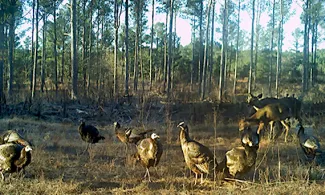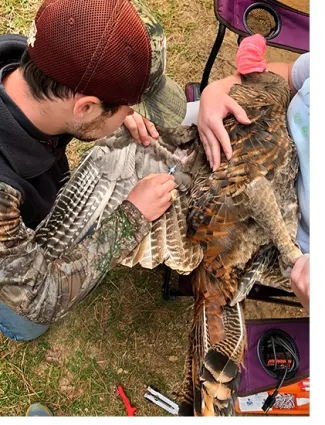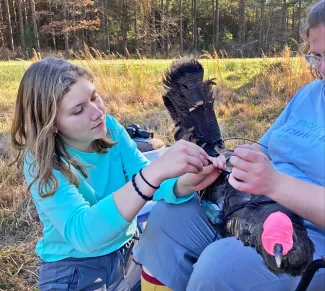
Game camera image of wild turkey and white-tailed deer at a baited research site.
Wild Turkey Population Dynamics and Brood Survival Project Report for March 2022
Provided by Oklahoma Cooperative Fish and Wildlife Research Unit, Oklahoma State University
An assessment of wild turkey genetic health is an important focus of a 4 1/2-year study launched at the beginning of 2022 by the Oklahoma Department of Wildlife Conservation and the Oklahoma Cooperative Fish and Wildlife Research Unit to address wild turkey population dynamics and brood survival.

Researchers take a blood sample from a turkey hen as part of genetics testing.

Researchers fit a VHF transmitter to a capture turkey hen.
Study personnel contacted several groups that offered to help collect tissue samples during March, including the Wildlife Department, the Cherokee Nation, the Muscogee (Creek) Nation, and numerous people affiliated with the National Wild Turkey Federation.
Genetics kits were sent to these contacts. Sample kits are continually being sent to members of the National Wild Turkey Federation as they make contact. At the end of March, about 250 genetics kits had been distributed.
For the southeastern portion of the study, researchers continued trapping efforts through March. Initially, we experienced problems with rocket nets misfiring, which resulted in a failed capture attempt in which all nine targeted hens escaped unharmed. After consultation with the manufacturer and colleagues using rocket nets, researchers were able to resolve the issues and have since successfully launched the net an additional three times.
By the end of March, study personnel had captured 22 hens, one jake, and two toms. All 22 hens were fitted with backpack-style transmitters, but one hen was killed by an unknown predator, leaving 21 hens transmitting at the end of the month.
Of the deployed transmitters, 11 were using standard VHF and 10 were using GPS. Of the GPS-transmitters, five feature data download via VHF and five transmit data automatically via Iridium satellites. This is the first time Iridium tags have been used on wild turkeys, and thus far, the technology appears to be working well, as all tags are transmitting data regularly.
All captured turkeys were banded and had blood and feather samples taken before release. Trapping will continue into April. Additionally, the project secured access to several promising trapping locations on private property in the area.
During April and May, researchers would be locating the hens when they are nesting. Nests will be closely observed to determine hatching success, nest abandonment, and any nest predation. This nesting information is critical in finding out how nesting success rates might be contributing to a turkey population decline.
For the southwestern portion of the study, a planning meeting with collaborators is scheduled at Sandy Sanders Wildlife Management Area in early May to discuss the upcoming fall/winter field season and check out study site locations and potential trapping locations.
(This research is funded through the Wildlife Restoration Program F21AF02702 (W-216-R-1) and the Oklahoma State University.)
Wild Turkey Population Dynamics and Brood Survival Project Report for March 2022
Provided by Oklahoma Cooperative Fish and Wildlife Research Unit, Oklahoma State University
An assessment of wild turkey genetic health is an important focus of a 4 1/2-year study launched at the beginning of 2022 by the Oklahoma Department of Wildlife Conservation and the Oklahoma Cooperative Fish and Wildlife Research Unit to address wild turkey population dynamics and brood survival.

Researchers take a blood sample from a turkey hen as part of genetics testing.

Researchers fit a VHF transmitter to a capture turkey hen.
Study personnel contacted several groups that offered to help collect tissue samples during March, including the Wildlife Department, the Cherokee Nation, the Muscogee (Creek) Nation, and numerous people affiliated with the National Wild Turkey Federation.
Genetics kits were sent to these contacts. Sample kits are continually being sent to members of the National Wild Turkey Federation as they make contact. At the end of March, about 250 genetics kits had been distributed.
For the southeastern portion of the study, researchers continued trapping efforts through March. Initially, we experienced problems with rocket nets misfiring, which resulted in a failed capture attempt in which all nine targeted hens escaped unharmed. After consultation with the manufacturer and colleagues using rocket nets, researchers were able to resolve the issues and have since successfully launched the net an additional three times.
By the end of March, study personnel had captured 22 hens, one jake, and two toms. All 22 hens were fitted with backpack-style transmitters, but one hen was killed by an unknown predator, leaving 21 hens transmitting at the end of the month.
Of the deployed transmitters, 11 were using standard VHF and 10 were using GPS. Of the GPS-transmitters, five feature data download via VHF and five transmit data automatically via Iridium satellites. This is the first time Iridium tags have been used on wild turkeys, and thus far, the technology appears to be working well, as all tags are transmitting data regularly.
All captured turkeys were banded and had blood and feather samples taken before release. Trapping will continue into April. Additionally, the project secured access to several promising trapping locations on private property in the area.
During April and May, researchers would be locating the hens when they are nesting. Nests will be closely observed to determine hatching success, nest abandonment, and any nest predation. This nesting information is critical in finding out how nesting success rates might be contributing to a turkey population decline.
For the southwestern portion of the study, a planning meeting with collaborators is scheduled at Sandy Sanders Wildlife Management Area in early May to discuss the upcoming fall/winter field season and check out study site locations and potential trapping locations.
(This research is funded through the Wildlife Restoration Program F21AF02702 (W-216-R-1) and the Oklahoma State University.)